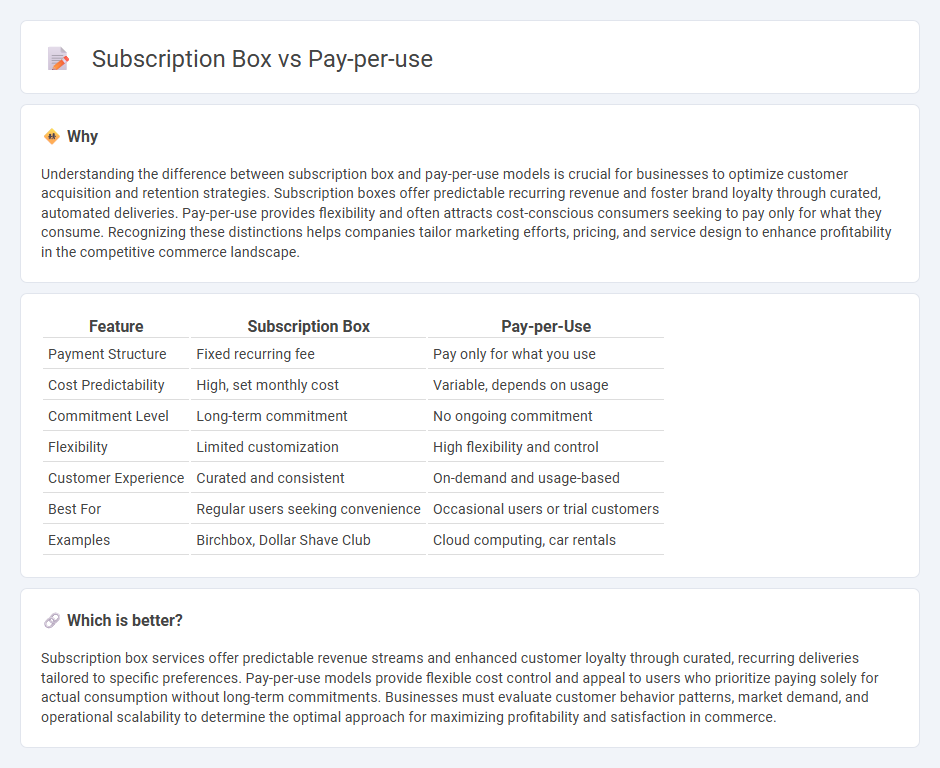
Subscription box services offer consumers curated products delivered regularly, providing convenience and predictable costs, while pay-per-use models charge customers based on actual consumption, appealing to those seeking flexibility and control. Subscription boxes often boost customer loyalty and lifetime value through ongoing engagement, whereas pay-per-use options reduce commitment, attracting users hesitant about long-term contracts. Explore the advantages and challenges of each model to determine the best fit for your business strategy.
Why it is important
Understanding the difference between subscription box and pay-per-use models is crucial for businesses to optimize customer acquisition and retention strategies. Subscription boxes offer predictable recurring revenue and foster brand loyalty through curated, automated deliveries. Pay-per-use provides flexibility and often attracts cost-conscious consumers seeking to pay only for what they consume. Recognizing these distinctions helps companies tailor marketing efforts, pricing, and service design to enhance profitability in the competitive commerce landscape.
Comparison Table
| Feature | Subscription Box | Pay-per-Use |
|---|---|---|
| Payment Structure | Fixed recurring fee | Pay only for what you use |
| Cost Predictability | High, set monthly cost | Variable, depends on usage |
| Commitment Level | Long-term commitment | No ongoing commitment |
| Flexibility | Limited customization | High flexibility and control |
| Customer Experience | Curated and consistent | On-demand and usage-based |
| Best For | Regular users seeking convenience | Occasional users or trial customers |
| Examples | Birchbox, Dollar Shave Club | Cloud computing, car rentals |
Which is better?
Subscription box services offer predictable revenue streams and enhanced customer loyalty through curated, recurring deliveries tailored to specific preferences. Pay-per-use models provide flexible cost control and appeal to users who prioritize paying solely for actual consumption without long-term commitments. Businesses must evaluate customer behavior patterns, market demand, and operational scalability to determine the optimal approach for maximizing profitability and satisfaction in commerce.
Connection
Subscription box and pay-per-use models intersect in commerce by offering flexible consumer choices and tailored purchasing experiences. Subscription boxes provide curated products delivered regularly, enhancing customer retention through predictable revenue and targeted personalization. Pay-per-use complements this by enabling consumers to access specific services or items according to actual usage, promoting cost efficiency and convenience within the subscription ecosystem.
Key Terms
Pricing Model
Pay-per-use pricing allows customers to pay only for the products or services they consume, offering flexibility and cost control without long-term commitments. Subscription boxes charge a recurring fee, providing predictable revenue for businesses and curated experiences for subscribers, often with added convenience and exclusives. Explore deeper insights into which pricing model best suits your business goals and customer preferences.
Customer Retention
Pay-per-use models increase customer retention by offering flexibility and personalized spending, appealing to consumers seeking control over their usage and expenses. Subscription boxes foster loyalty through curated experiences and predictable delivery, creating habitual engagement and brand connection. Explore strategies to optimize retention by balancing usage freedom with consistent value in your offerings.
Revenue Predictability
Pay-per-use models generate revenue based on actual customer consumption, leading to variable income streams and challenges in forecasting monthly earnings. Subscription boxes provide predictable, recurring revenue through fixed-period payments, enhancing financial stability and facilitating better cash flow management for businesses. Explore these models further to determine the best approach for maximizing your revenue predictability.
Source and External Links
What Is Pay-Per-Use? | Revenera - Pay-per-use is a monetization model where users are charged based on metered consumption of a product or service, commonly used in software licensing and SaaS, aligning cost with actual usage and value delivered to customers.
Business Model: Pay-Per-Use - Reason Street - This model charges customers each time they use a product or service without fixed fees, differing from subscriptions by its flexible metering approach, and is also known as usage-based or consumption-based pricing.
Business model: Pay Per Use - Learning Loop - Pay-per-use pricing involves selecting a usage metric that directly correlates with customer value, enabling billing based on actual consumption, often supported by modern technologies for accurate metering and flexible billing.
 dowidth.com
dowidth.com